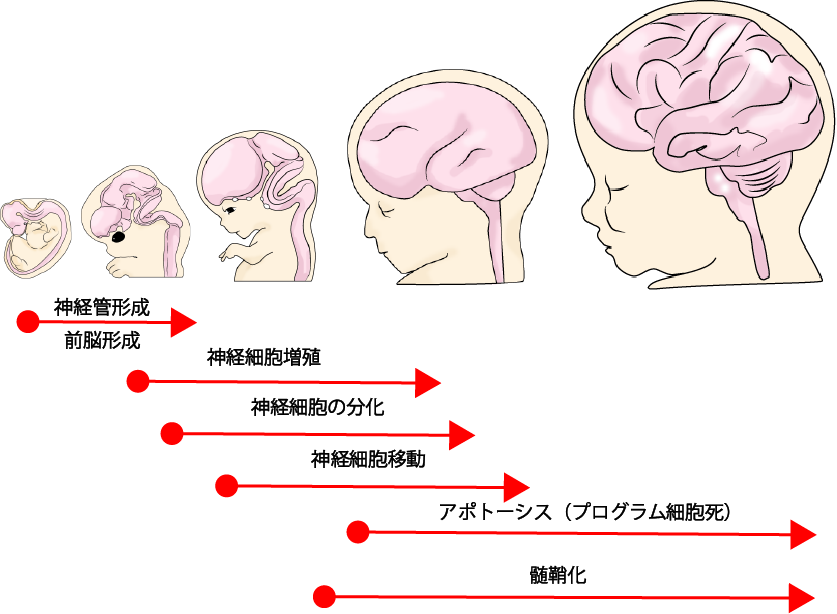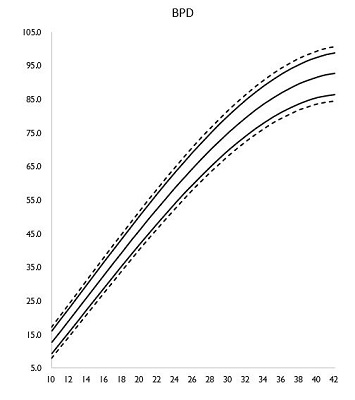Growth during pregnancy
- TOP
- Fetal Medicine
- Growth during pregnancy
Growth during pregnancy
When you find out you are pregnant, you may be wondering how the fetus will grow. Here is an explanation of the growth of the fetus in terms of the size of its body parts.
Until the fetal form is formed.

At 6 weeks gestation, the embryo gradually begins to form organs and nerves, but the head is still small and it is difficult to tell which is the head and which is the buttocks. At 7 weeks, the shape of the fetus, though small, can be seen and the tiny figure can be confirmed on ultrasound. The heart appears to be beating outside the body and looks like a fish.
By the time you reach the 8 weeks of pregnancy, you can clearly see the fetus on the ultrasound, and you can also see small arms and legs moving. The fetus’s head will be large and will be 2.5 cm tall. At 10 weeks gestation, the fetus is called a fetus, and the fingers and toes are clearly visible. On the ultrasound, you can see the movements of a really cute fetus.
Development of the Embryo
In the first half of 7 weeks of pregnancy, the body of the fetus is still not clearly visible, but in the second half of the seventh week, the eyes, nerves, organs, etc. are forming and the fetus is gradually becoming visible. At this time, the fetus is still only 7 to 8 mm in size. An ultrasound scan will still only show a small image, but it will be possible to see the heartbeat. (To be precise, the fetus is called “embryo bud” around 8 weeks of pregnancy, not “fetus.”))
By the ninth week, the fetus is growing rapidly, and the shape of the hands and eyes can be identified little by little. 10 weeks later, the fetus is about 3 cm in size. At 10 weeks, the fetus is around 3 cm in size, and the face is becoming clearer, with eyelids and ears recognizable. The heart divides into four chambers and the genitals begin to develop, but at this point the sex is not yet determined.
The Growth Process of the Fetal Brain
Until the eighth week of pregnancy, the fetus is not officially called a “fetus” but an “embryo. The brain is still in its infancy and is still preparing for the dramatic growth that is to come. After 9 weeks of pregnancy, the fetus is called a fetus, and you can see its movements on the ultrasound. After 12 weeks, you will be able to see the fetus’s hands goop and sometimes even open its mouth, which makes for very cute ultrasound pictures.
At 13 to 16 weeks, the newborn’s brain nerves move to the surface of the brain to form the cerebral cortex. Many mothers enjoy taking videos of their fetuses’ movements as they move their limbs and bodies actively.
At 16 weeks, the fetus weighs over 100 grams, and at 17-18 weeks, the fetus is around 20 cm tall. The little body is growing rapidly. After that, the fetus gets bigger and bigger, and when it reaches 29-30 weeks, wrinkles start to appear on the surface of the brain and brain growth becomes more active. The size of the fetus at this time is around 45cm. At this time, the fetus is around 45cm in length, and is ready to be born at any time.

See Fetal brain outpatient care
Growth graph of the fetal body
The fetus forms all of its organs, organs, brain, etc. at approximately 40 weeks. Let’s take a look at the growth of each part of the body.

Biparietal diameter(BPD)

The formation of the head, along with the heart, organs, and nerves, begins relatively early. As early as 8-9 weeks of pregnancy, the brain can be seen on ultrasound as it divides into two parts, left and right. The transverse diameter of the head at 10 weeks is still only about 10 mm, but it develops at a very fast rate, growing to 40-50 mm at 20 weeks. By this time, the entire face, ears and neck can be clearly seen on ultrasound.
By the 36 weeks, the head turns downward and begins to be fixed to the pelvis. At this time, the frequency of fetal movement tends to decrease.
Abdominal circumference(AC)

The abdominal circumference of a fetus at 16 weeks gestation is only about 10 cm, smaller than the wrist circumference of an adult woman; at 20 weeks, it grows to about 15 cm, and at 32 weeks, it grows to about 25 cm. Organ formation begins early in pregnancy, but it continues to grow until 32 weeks, when it acquires full traits in the remaining weeks. The abdominal circumference at birth varies somewhat from person to person, but it will be around 35 cm.
Femur length(FL)

The femur is the “thigh” bone. At 16 weeks of pregnancy, the femur is only 15-20mm long, but at 30 weeks, it grows to 50-60mm, and just before delivery, it grows to 70-80mm. The “fetal movement” that a pregnant woman feels varies from person to person, but it starts to be felt around 18 to 19 weeks.
This is because the legs moved by the fetus hit the belly of the pregnant woman as the femur grows. At around 20-28 weeks, the fetus’s femur has developed so much that you can feel it kicking against your belly.
Body weight

At around 18 weeks, the fetus weighs only about 200 grams, but by 30 weeks, it has grown to about 1,500 grams, which is about half of its birth weight. By 40 weeks, the weight of the fetus has increased to about 3,000 grams, and many pregnant women are surprised by the sudden change.
